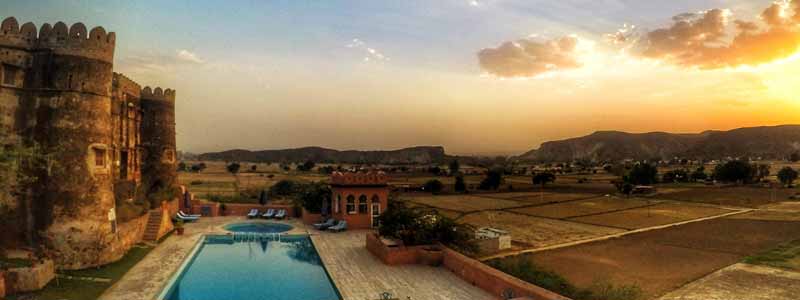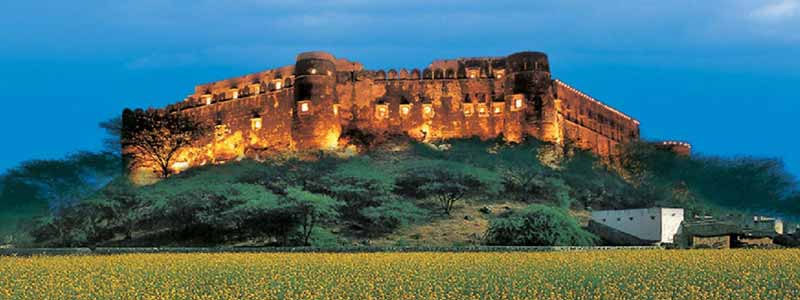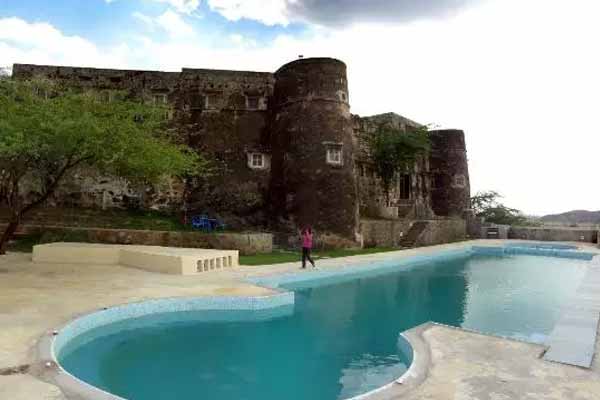Kesroli Hill Fort is one of the rare heritage hotels in Alwar that has been in existence since the 14th century. A wonderful destination to enjoy the barrier sunsets, showing daily since 700 years and discovering the Neemrana heritage hotels in Alwar is this resort. Hill Fort-Kesroli is a great holiday choice for those looking for a relaxing weekend getaway from Delhi.
Built in the14th century, Neemrana’s Kesroli Hill Fort is a spectacular ancient heritage palace that will take you back in history. This fort is surrounded by fields all around. The hotel has a huge swimming pool and a beautiful garden. The rooms are decorated in a typically Rajasthani style which giving it a royal feel.

History:
Kesroli Hill Fort, Alwar was made by the Yaduvanshi Rajputs. Earlier in the 14th century, they were converted into Islams and were known as ‘Khanzadas’. The design and structure of this Kesroli Hill Fort had to undergo plenty of alterations during several centuries and according to the culture of its ruler occupants. From the hands of Mughals and Jats, finally, Rajputs’ reign has come to this historic fort in 1775. Many rulers came and gone but it was during the ruling period of Ranawat Thakur Bhawani Singh, the fort witnessed its golden period Rajasthan Monuments.

Architecture
Kesroli Hill Fort, Alwar is built upon a large-sized rock and lies above the sea level. The splendid layout and design of this fort make it superior attractive. To watch out the soldiers, it is surrounded by a strong wall with towers. Arched verandahs give it an artistic look. Granite stone has been used to build the main fort and many pillars are supporting it. It is the nature of this stone that makes the ambiance cool inside the building Rajasthan Budget Tours.
The fort building is square-shaped which includes many gigantic rooms and halls. Large windows inside the rooms make them airy and bring enough lights inside them. The majestic roof is no less attractive. From the fort, you can admire a better view of Alwar.
The architectural designs and features of the fort are splendid in the forms of arched verandahs, ramparts, and turrets. There is a total of 7 turrets but their design patterns have undergone several changes many times under different rulers. Finally, in 2004, Francis Wacziarg and Aman Nath of Neermana Hotels Group took the lease of this Kesroli Hill Fort, Alwar. They gave a facelift to this place and turned it into a heritage hotel.
Best Time To Visit Kesroli
The months of November-February are the best time to visit this place as the winter months in this area are very pleasant. Summers can get quite hot here and the temperature rises very high. The monsoon brings relief and the temperature drops Kesroli Hill Fort.
How to reach Kesroli
Air: Jaipur (152kms), New Delhi (160kms), Agra (170kms) are the nearest airports to the place. You can take a bus or hire a taxi from here to reach Kesroli Hill Fort.
Rail: Nearest Railway Station to Kesroli Hill Fort is Alwar. You will have to take a taxi from here to reach the Kesroli.
Road: Regular buses are available from all the nearby major cities such as Gurgaon (130kms), Jaipur (152kms), Agra (170kms), Noida (175kms), New Delhi (160kms) to Kesroli Hill Fort.
